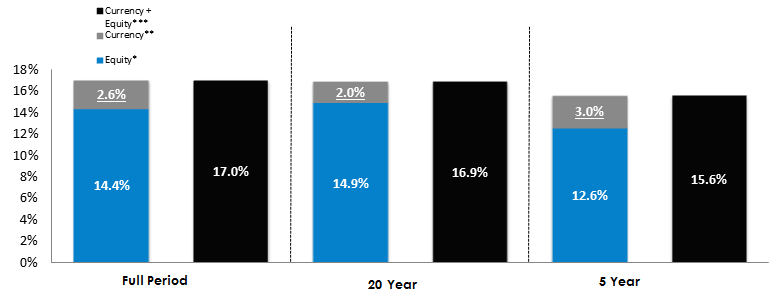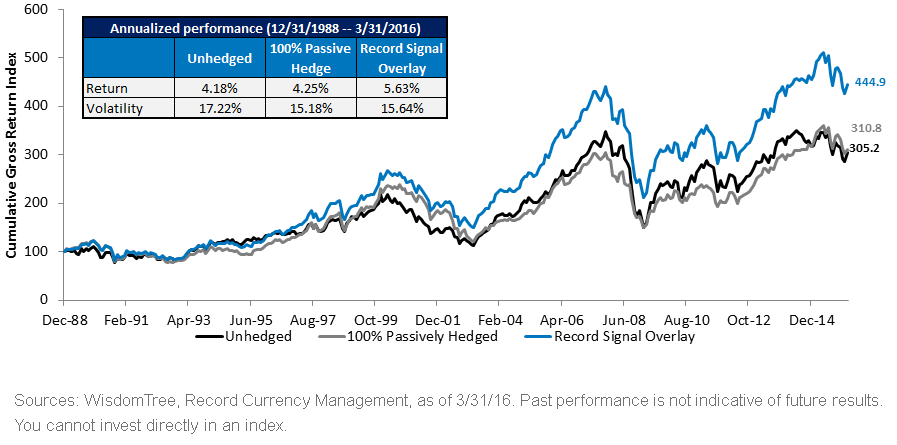Rethink Your International Allocations



 For definitions of terms in the chart visit our glossary.
I believe the long-run, strategic portfolio framework with the most sound underpinnings for international allocations incorporates one of two mindsets:
1) Strategically hedging currencies in the developed world as a baseline allocation all the time. This strategy, for broad baskets of international equities, can lower the volatility profile of international investing and means an investor does not have to worry about fluctuations in exchange rates.
Volatility Reduction: Over the last 47 years, currency has added 260 basis points (bps) to the volatility of stocks in the MSCI EAFE Index, despite having nearly zero correlation to those stocks.1 The evidence shows that, far from being an actual diversifier to a portfolio, foreign currency exposure is nothing more than a bet on foreign currencies appreciating in value. Sometimes the bet pays off, sometimes not.
If an investor wants to eliminate the need to make any calls or bets on currency directions, strategically hedging currency risk all the time is the most natural approach to achieving this goal, in my opinion.
Note, I believe most investors still think of this backwards, claiming the decision to “currency hedge” is the “active bet” they must make. But remember, currency hedging just seeks to neutralize exposure so that a portfolio doesn’t stand to benefit when the euro rises or doesn’t get hurt when the euro falls.
2) Dynamically Hedged currency exposure to adapt unhedged positions when hedging looks less attractive. Of course, there are times when foreign currencies will appreciate in value. But can you time those adaptive hedging moves yourself? Research we have conducted with Record Currency Management shows that it’s possible to add value over passive hedging (or unhedging) all the time.
Over the last 28 years, determining when to currency hedge using a three-factor model of interest rate differentials, momentum and currency valuations has added more than 140 bps annually to the returns of a broad international hedged-equity strategy while maintaining the vast majority of the volatility reduction of strategic passive hedging.2 This research led us to offer a family of dynamic currency-hedged Indexes that represent this exposure for broad international allocations, European allocations and Japanese allocations.
Unhedged MSCI EAFE Index with Passive Hedged and Signal Overlay (12/31/1988—3/31/2016—USD Based)
For definitions of terms in the chart visit our glossary.
I believe the long-run, strategic portfolio framework with the most sound underpinnings for international allocations incorporates one of two mindsets:
1) Strategically hedging currencies in the developed world as a baseline allocation all the time. This strategy, for broad baskets of international equities, can lower the volatility profile of international investing and means an investor does not have to worry about fluctuations in exchange rates.
Volatility Reduction: Over the last 47 years, currency has added 260 basis points (bps) to the volatility of stocks in the MSCI EAFE Index, despite having nearly zero correlation to those stocks.1 The evidence shows that, far from being an actual diversifier to a portfolio, foreign currency exposure is nothing more than a bet on foreign currencies appreciating in value. Sometimes the bet pays off, sometimes not.
If an investor wants to eliminate the need to make any calls or bets on currency directions, strategically hedging currency risk all the time is the most natural approach to achieving this goal, in my opinion.
Note, I believe most investors still think of this backwards, claiming the decision to “currency hedge” is the “active bet” they must make. But remember, currency hedging just seeks to neutralize exposure so that a portfolio doesn’t stand to benefit when the euro rises or doesn’t get hurt when the euro falls.
2) Dynamically Hedged currency exposure to adapt unhedged positions when hedging looks less attractive. Of course, there are times when foreign currencies will appreciate in value. But can you time those adaptive hedging moves yourself? Research we have conducted with Record Currency Management shows that it’s possible to add value over passive hedging (or unhedging) all the time.
Over the last 28 years, determining when to currency hedge using a three-factor model of interest rate differentials, momentum and currency valuations has added more than 140 bps annually to the returns of a broad international hedged-equity strategy while maintaining the vast majority of the volatility reduction of strategic passive hedging.2 This research led us to offer a family of dynamic currency-hedged Indexes that represent this exposure for broad international allocations, European allocations and Japanese allocations.
Unhedged MSCI EAFE Index with Passive Hedged and Signal Overlay (12/31/1988—3/31/2016—USD Based)
 Most investors remain unhedged for their broad-based allocations to the foreign large-cap asset class. To me, this is the least sensible and defensible strategy over the long run. We know currency adds to an investor’s risk profile, and we believe there should be no “expected return” from these currencies (the “uncompensated risk” of currency).
The case for currency hedging remains as strong today as ever. This case mostly relies on being able to achieve a potentially lower risk profile when investing internationally.
The case is enhanced by the fact that the European and Japanese central banks have instituted negative interest rates, while the U.S. central bank is on a gradual glide path to raising interest rates. Far from being a cost to hedge the euro and yen, an investor is increasingly being paid interest rate differentials between the U.S. and the foreign central banks. The amount an investor is being paid to hedge using one-month forward contracts is approaching 75 bps in the euro area and almost 70 bps in Japan.3
On a Tactical Basis, Hedging Is Still Attractive
Interest rate differentials are perhaps the most powerful motivating force for long-run capital flows. The U.S. has among the highest interest rates in the developed world.
In Japan, not only is there a negative short-term yield, the 10-year government bond has a negative yield. These low yields increasingly encourage Japanese corporations, pension funds and citizens to look for opportunities to earn higher yields around the globe. The U.S. is likely going to be a recipient of these flows for an extended period.
While I remain tactically bullish on the dollar based on the longer-term trend in interest rates, it’s not necessary to be a U.S. dollar bull to adopt currency-hedged strategies. An investor just needs to accept the proposition that currency adds to the risk profile of international investments for no expected long-term benefit.
I believe that, as investors come to realize how much uncompensated risk they may be taking and that foreign equities could continue to look attractively priced compared to U.S. equities, investors may continue to shift portfolios toward either strategic or dynamic currency-hedged international strategies.
1Sources: WisdomTree, Bloomberg, as of 3/31/16.
2Sources: WisdomTree, Record Currency Management, as of 3/31/16.
3Sources: WisdomTree, Bloomberg, as of 3/31/16.
Most investors remain unhedged for their broad-based allocations to the foreign large-cap asset class. To me, this is the least sensible and defensible strategy over the long run. We know currency adds to an investor’s risk profile, and we believe there should be no “expected return” from these currencies (the “uncompensated risk” of currency).
The case for currency hedging remains as strong today as ever. This case mostly relies on being able to achieve a potentially lower risk profile when investing internationally.
The case is enhanced by the fact that the European and Japanese central banks have instituted negative interest rates, while the U.S. central bank is on a gradual glide path to raising interest rates. Far from being a cost to hedge the euro and yen, an investor is increasingly being paid interest rate differentials between the U.S. and the foreign central banks. The amount an investor is being paid to hedge using one-month forward contracts is approaching 75 bps in the euro area and almost 70 bps in Japan.3
On a Tactical Basis, Hedging Is Still Attractive
Interest rate differentials are perhaps the most powerful motivating force for long-run capital flows. The U.S. has among the highest interest rates in the developed world.
In Japan, not only is there a negative short-term yield, the 10-year government bond has a negative yield. These low yields increasingly encourage Japanese corporations, pension funds and citizens to look for opportunities to earn higher yields around the globe. The U.S. is likely going to be a recipient of these flows for an extended period.
While I remain tactically bullish on the dollar based on the longer-term trend in interest rates, it’s not necessary to be a U.S. dollar bull to adopt currency-hedged strategies. An investor just needs to accept the proposition that currency adds to the risk profile of international investments for no expected long-term benefit.
I believe that, as investors come to realize how much uncompensated risk they may be taking and that foreign equities could continue to look attractively priced compared to U.S. equities, investors may continue to shift portfolios toward either strategic or dynamic currency-hedged international strategies.
1Sources: WisdomTree, Bloomberg, as of 3/31/16.
2Sources: WisdomTree, Record Currency Management, as of 3/31/16.
3Sources: WisdomTree, Bloomberg, as of 3/31/16. Important Risks Related to this Article
Hedging can help returns when a foreign currency depreciates against the U.S. dollar, but it can hurt when the foreign currency appreciates against the U.S. dollar.
Foreign investing involves special risks, such as risk of loss from currency fluctuation or political or economic uncertainty.
Investments focused in Europe or Japan increase the impact of events and developments associated with the regions, which can adversely affect performance.
No WisdomTree Fund is sponsored, endorsed, sold or promoted by Record Currency Management (“Record”). Record has licensed certain rights to WisdomTree Investments, Inc., as the index provider to the applicable WisdomTree Funds, and Record is providing no investment advice to any WisdomTree Fund or its advisors. Record makes no representation or warranty, expressed or implied, to the owners of any WisdomTree Fund regarding any associated risks or the advisability of investing in any WisdomTree Fund.

Jeremy Schwartz has served as our Global Chief Investment Officer since November 2021 and leads WisdomTree’s investment strategy team in the construction of WisdomTree’s equity Indexes, quantitative active strategies and multi-asset Model Portfolios. Jeremy joined WisdomTree in May 2005 as a Senior Analyst, adding Deputy Director of Research to his responsibilities in February 2007. He served as Director of Research from October 2008 to October 2018 and as Global Head of Research from November 2018 to November 2021. Before joining WisdomTree, he was a head research assistant for Professor Jeremy Siegel and, in 2022, became his co-author on the sixth edition of the book Stocks for the Long Run. Jeremy is also co-author of the Financial Analysts Journal paper “What Happened to the Original Stocks in the S&P 500?” He received his B.S. in economics from The Wharton School of the University of Pennsylvania and hosts the Wharton Business Radio program Behind the Markets on SiriusXM 132. Jeremy is a member of the CFA Society of Philadelphia.

